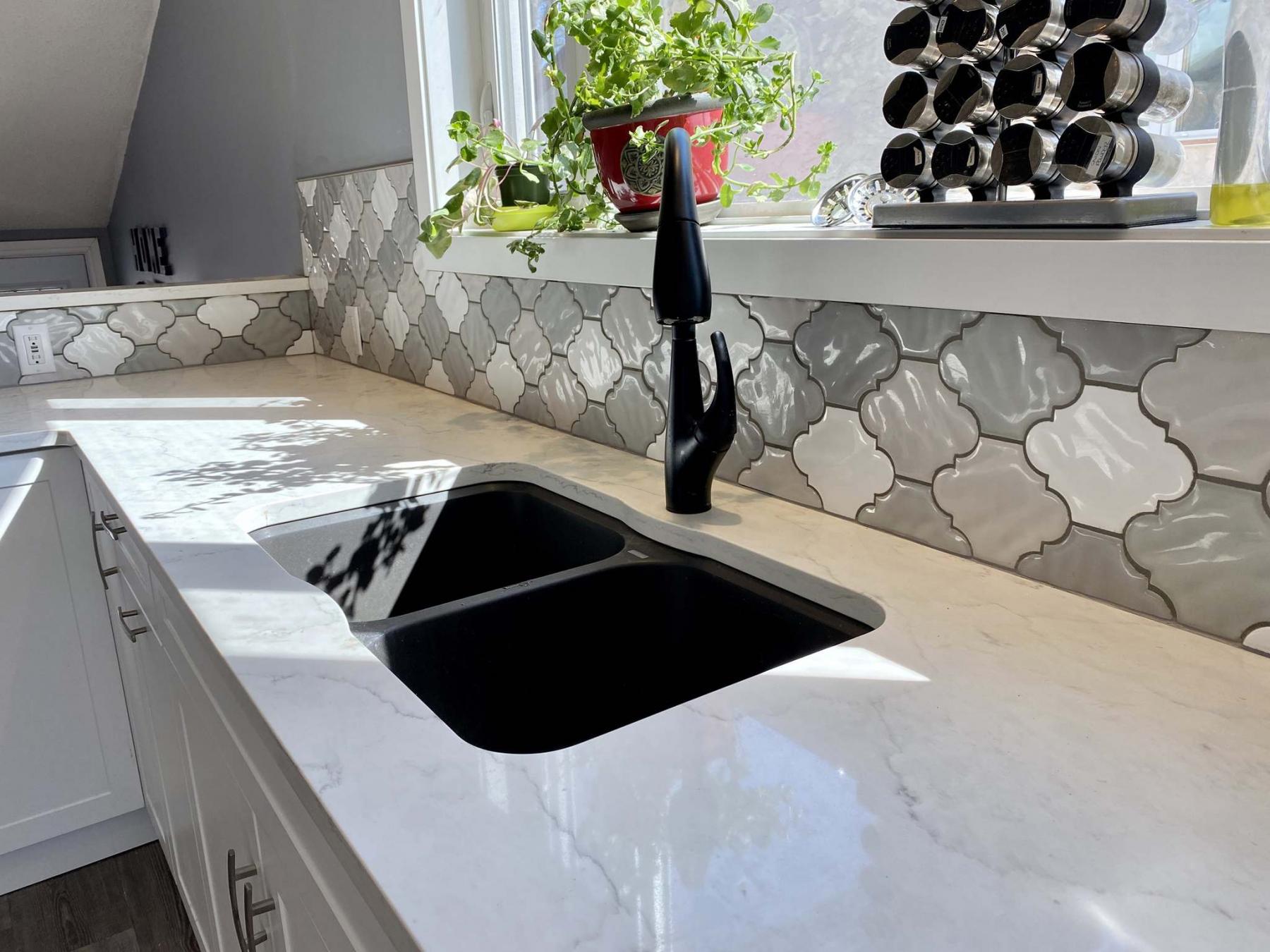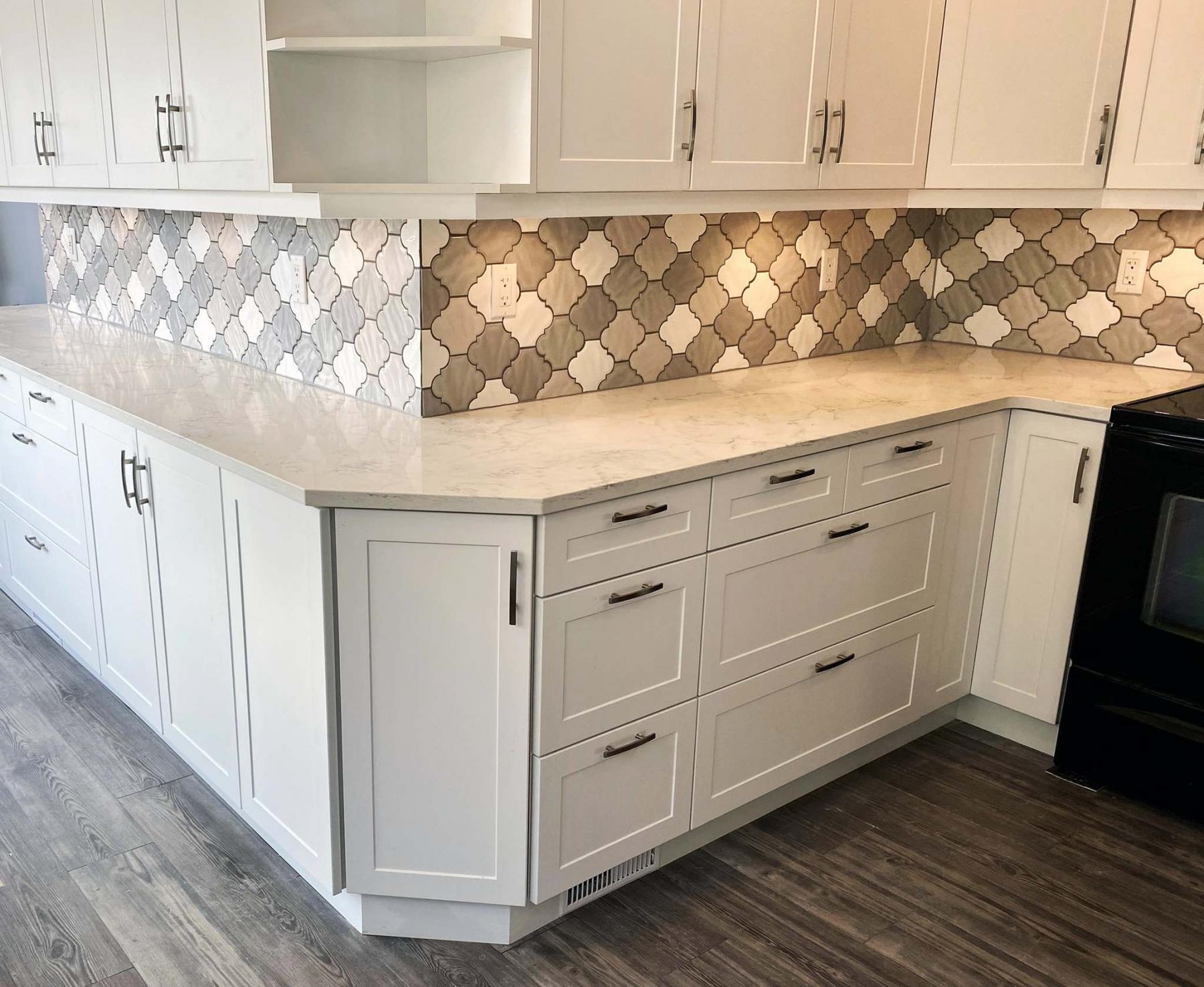
Despite the narrow surface, the pattern continues between the countertop tiers.
A kitchen renovation can be very invasive. When the project calls for an entire gut and remodel, the area can be rendered non-functional for as long as eight weeks. This is why I often retain the old sink and a portion of the old lower cupboards and countertop, and temporarily tie-in the old sink to the new rough plumbing until the new sink can be installed once the new cupboards and countertops have arrived.
There are so many intricate steps to a kitchen remodel. Yet, it is the final few that are forever remembered simply because they provide the everlasting esthetics of the design. Specific design elements showcase the subjective choices of clients, which best represent their style. In my experience, nothing achieves this more than the kitchen backsplash. Sure, the cupboards and countertops can also drastically vary in style and colour. But, the backsplash truly emphasizes individual style and personality.
It is nearly impossible to remember every kitchen renovation at this point — the most recent stand out simply because they are recent. However, a select few have remained lodged in my frontal lobe, simply because the backsplash tile choice either conflicted with my own tastes, or it was a type of tile I had never even envisioned up to that point.
During a recent kitchen reno, my client was very particular about the tile she wanted. After visiting AMES Tile & Stone (a RONA supplier), the tile she chose was a sort of oddly rounded diamond-shaped tile, in four different colours. It was a discounted line, so we were able to secure the tile at a very good price. It was shipped from Calgary and arrived well before we needed it — backsplash tiling is usually one of the last steps of a kitchen project.
Unlike a standard backsplash, mesh mosaic tile (the tile pattern is pre-set as 12x12-inch sheet of tile), these tiles were all individual. As such, a repeating pattern would need to be established before tiling could begin. If the tile were set in a random fashion, there was a chance that color groupings of tile could render the design unbalanced — after all that work, this was not a chance I was willing to take. It was not as easy as it seems. The tiles are roughly 5x6-inches — creating a repeating pattern layout would require no less than an area of two or three square-feet, a substantial area of any backsplash location. After a few tries, the simplest pattern was set up by assigning each of the four colours a number, and the numbers were distributed in order. By doing this, it gave me a systematic process of how to lay the tiles, without any guessing. Once it was completed, the tile colour arrangement was random enough to not catch the eye, yet consistent enough to avoid any unwanted areas of ‘heavy groupings’ of one or more colours. To further complicate the process, the initial row along the countertop required a straight edge, which meant the first row of tiles needed to be cut down in such a manner as to allow this.
When using mesh mosaic tile sheets, all of this is avoided; the much smaller tiles are already arranged in a consistent manner, and the bottom edge is usually already flat. As such, tiling mosaic is faster and much easier. However, the mosaic tile sheets do offer a potential negative — if the area being tiled is not perfectly square, shaving a bit of the narrow tiles of a mosaic will be highly visible, unlike shaving a larger tile. At a job a few years ago, the sink-side required backsplash along the countertop and below three separate windows. On the far right of the counter, the last window fell from square by nearly a full width of a one-inch tile of the mosaic. Angling the tile to fit would be an eyesore. To fix the issue, I cut the mesh along the grout line between all tiles and squeezed them closer together to fit the decreasing space between the window edge and the countertop. This did the trick. Once grouted, the illusion of square was created by not trimming the tiles, and allowing all grout lines to progressively narrow as needed.
Not everyone has the same tastes. This is always so apparent when strolling through the aisles at any tile centre — there are literally thousands of tile choices. And although I may not always understand a client’s tile choice, only two things really matter; if the tile choice makes the client happy, and also suits the kitchen, who am I to influence otherwise? I only really need to focus on one thing— ensuring the tile is installed properly. That’s what makes me happiest.
BossEnterprise@outlook.com




